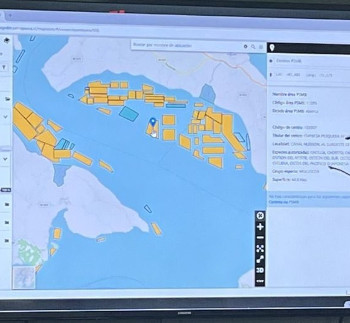|

Image: Mejillón de Chile / FIS
Revolution in Mussel Farming: Sernapesca Launches Real-Time Monitoring Platform to Optimize Production in Los Lagos
 CHILE
CHILE
Friday, July 12, 2024, 05:00 (GMT + 9)
This platform takes spatial objects that are operating on the coastal edge of the Los Lagos region and is updated with information on public services that serves for territorial and emergency planning. It provides unprecedented transparency, allowing all actors involved to have access to the same up-to-date information. The integration of productive and health data in real time not only improves the administrative and operational management of aquaculture activities, but also strengthens trust and cooperation between authorities and producers.
An innovative online tool designed to optimize the management and monitoring of aquaculture areas was presented by the National Fisheries and Aquaculture Service in a workshop aimed at services, universities and institutions that work with the mussel farming sector. The workshop was organized jointly by SERNAPESCA Los Lagos and the Regional Strategic Mussel Program (PER) of Mejillón de Chile, operated by Corfo Los Lagos
 de Sernapesca Los Lagos FIS Seafood Media.jpg) This real-time platform is updated with production and health data, allowing events such as the Red Tide and other environmental contingencies to be managed. Branny Montecinos, Regional Director (S) of Sernapesca Los Lagos explained that “this is a platform that takes space objects that are currently operating on the coastal edge of our region and is updated with information from Sernapesca itself, productive information, but also data of a sanitary nature, through sampling from the Bivalve Mollusc Health Program (PSMB) as information that can come from the Seremi de Salud to generate closures in the event of a Red Tide event.” This real-time platform is updated with production and health data, allowing events such as the Red Tide and other environmental contingencies to be managed. Branny Montecinos, Regional Director (S) of Sernapesca Los Lagos explained that “this is a platform that takes space objects that are currently operating on the coastal edge of our region and is updated with information from Sernapesca itself, productive information, but also data of a sanitary nature, through sampling from the Bivalve Mollusc Health Program (PSMB) as information that can come from the Seremi de Salud to generate closures in the event of a Red Tide event.”
He added that this viewer “serves to eventually be able to visualize a contingency of another type, be it environmental contamination, a spill or a mass mortality to know specifically who the users are in that location and how they could be affected,” said Montencinos.
 David Espinoza, regional director (S) of Corfo Los Lagos noted that “the platform also significantly reduces the information gap compared to what was available a decade ago. Previously, information on the productive and sanitary conditions of aquaculture areas was limited and often took time to reach users. This made it difficult to respond to events such as the Red Tide or other environmental contingencies," he explained. David Espinoza, regional director (S) of Corfo Los Lagos noted that “the platform also significantly reduces the information gap compared to what was available a decade ago. Previously, information on the productive and sanitary conditions of aquaculture areas was limited and often took time to reach users. This made it difficult to respond to events such as the Red Tide or other environmental contingencies," he explained.
"With this innovative tool, authorities can not only make more informed and timely decisions in response to specific events, but a direct benefit is also provided to mussel farmers and artisanal fishermen. The ability to know the closure zones online and in real time and the condition of the areas under the Bivalve Mollusk Health Program (PSMB) is a fundamental change. This allows users to better anticipate and plan their activities, such as harvest scheduling before a preventive closure, which can mean a. crucial difference in economic and operational terms," Espinoza highlighted.
.png) The possibility of identifying critical points and planning in advance contributes to more efficient and sustainable management of aquatic resources, benefiting the entire community," Espinoza concluded. The possibility of identifying critical points and planning in advance contributes to more efficient and sustainable management of aquatic resources, benefiting the entire community," Espinoza concluded.
On July 17, in the city of Castro, the Strategic Mussel Program will hold a new workshop aimed at mussel farmers to explain the uses of this territorial management viewer. “He taught us how to use this map viewer with productive information, the status of the red tide, without a doubt it is a tool with great potential, especially to be able to support production planning, identify critical points and as a tool to generate long-term productive planning and administrative management planning, which public services exercise over our activity,” said Javier Aros, the manager of the strategic program.
Source: Mejillón de Chile (Translated from the original in Spanish)
[email protected]
www.seafood.media
|



